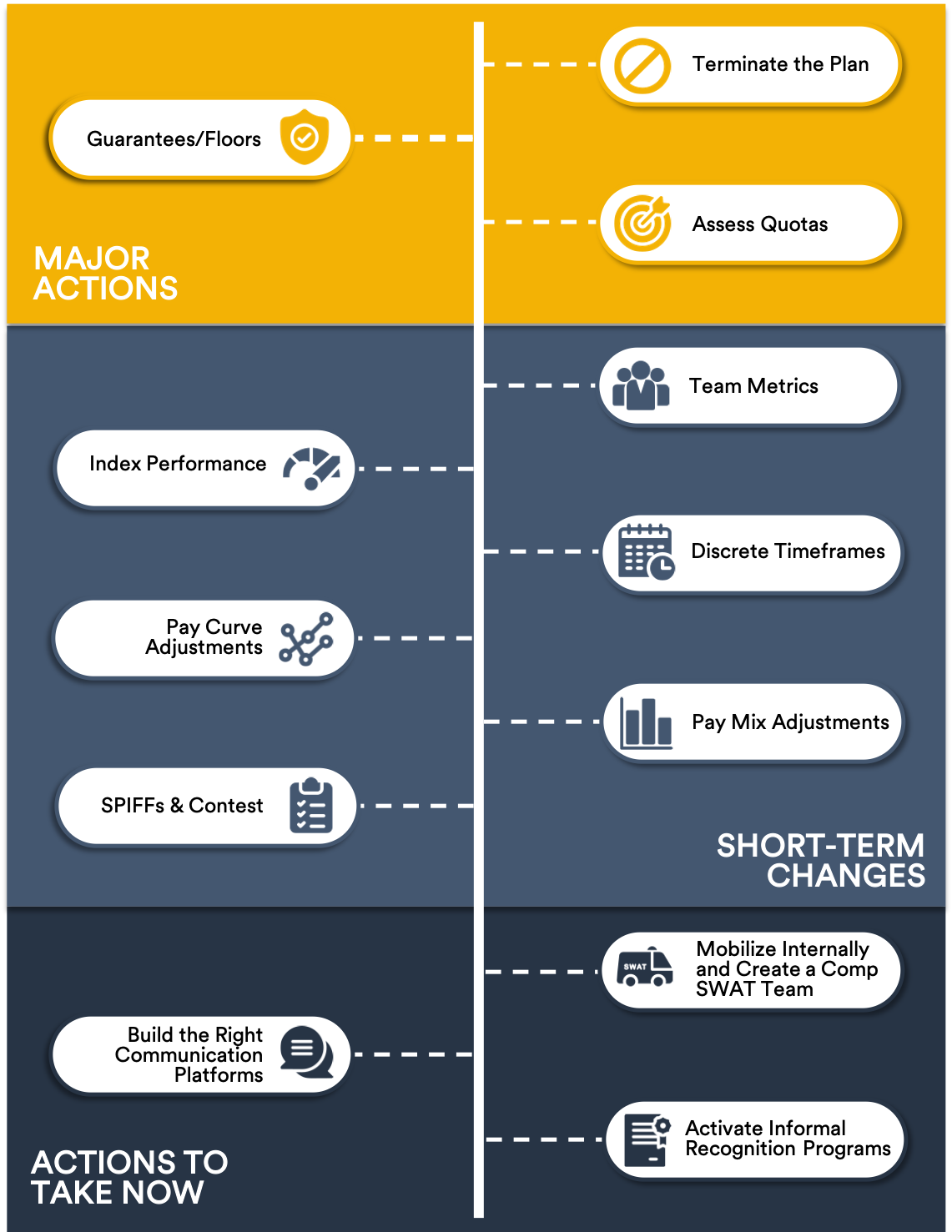There are various interpretations of what “quarantine” or “shelter in place” mean. Some think it’s ok to still go out-and-about, just keeping social distance. Others have gone full ‘survivalist’ mode, locked down with 10 years of toilet paper.
In uncertain times, people’s reactions can vary because there isn’t one “right” protocol. There are many actions that can be taken, but no perfect recipe for every situation.
The same is true as you look to adjust your sales compensation plan. We have fielded dozens of calls from clients asking:
- “What do I do for Q2 and beyond with our compensation plans?”
- “Should I keep my sales organization whole during times of uncertainty?”
- “Should I pay when sales are not closing deals?”
- “How should I reforecast and reallocate my goals?”
We started to address these questions here and here. Our general response is, it depends on your situation. A medical supply client is having a banner year while our entertainment and hospitality clients are being forced into very difficult decisions.
The good news is, there are many options to address sales compensation. These options span from low cost to minor tweaks to radical overhauls. We’ve created a sales compensation toolkit to help guide your changes.
SALES COMPENSATION COVID TOOLKIT

Foundational: Actions to Take Now
The following actions are low cost and will set your sales organization up for success.
- Mobilize Internally and Create a Comp SWAT Tea
You’re going to need broad organization support to make any changes. Identify the key stakeholders and build a cross-functional team of leaders. This team should directly own compensation and goal-related changes, exceptions, and communications. The actions might include short-term plan changes, one-off bonuses, goal relief, and pipeline adjustments. There should be one team, clearly empowered and equipped to carry out any and all changes. Team effectiveness and dynamics are key. Make sure the members are collaborative, focused, and aligned around common guardrails or design parameters.
- Build the Right Communication Platforms and Over-communicate
Now is not the time for leadership to hide. It’s also not the time for false positioning. Your sales team will see right through that. Authentic and genuine encouragement is required. Keep your sales team informed of everything you are doing to manage this quickly changing situation. Demonstrate you are there to support them, even in the face of shifting directions and fluid demands. Be forthcoming and acknowledge the things that you don’t know. Establish the right channels and cadence. The sales organization should clearly know the main communications channels to pay attention to. Other leaders and functions must be consistent as they cascade and reinforce the messages.
- Activate Informal Recognition Programs
Now is the time to highlight what specific reps are doing to be creative and add value to their clients. Celebrate even the small wins to encourage the team. Whether it’s a formal or informal program, everyone wants to be recognized. If budgets allow, the simple things matter these days. Think Uber Eats gift cards for those going above-and-beyond.
Minor Tweaks: Short-Term Changes
All of these changes must be carefully assessed to ensure the morale gains outweigh the bottom-line costs. In addition, clearly communicate that these are short-term adjustments for a finite period of time. The increase in cost-of-sales may outweigh the long-term impact of an understaffed and/or disgruntled sales team.
- SPIFFs & Contest
It’s counter intuitive to provide additional money when goals are missed. But small SPIFFs or add-on incentives help provide income, align pay and performance, and motivate. The right program can strengthen the overall culture and maintain team spirit. The program needs to be focused on near-term behaviors, such as pipeline activities, customer success stories, value content creation, or outright wins. The key to SPIFFS is they are clearly defined for a short-term behavior change. SPIFFS are not band-aids to bridge 100% of their income. Reps may not be able to control the outside world, but they can control their approach and activities during this unique time.
- Pay Mix Adjustments
With pipelines drying up, the opportunity to earn incentive dollars is compromised. This can have a HUGE impact on a high performer’s wallet, where a significant percent of their total compensation is upside paid out on overperformance. Leadership can consider shifting some of the potential incentive dollars to fixed dollars. The increase of guaranteed money may help the stress level of your sales team. For instance, a BDR’s pay mix can be 50% fixed/50% incentive. A shift to 60/40 or even 70/30 will increase the fixed amount and reward the rep for value-added activities that may not lead to immediate wins.
- Pay Curve Adjustments
Similar to pay mix adjustments, leadership can consider a higher payout percentage for performance under goal. For example, if a plan usually pays $.50 on the dollar for performance under goal, it can shift to 1:1 payout for reps above a specific threshold such as 90%. Another consideration could be lowering or removing the threshold altogether and paying from first dollar.
- Discrete Timeframes
One of the more common changes we’re seeing is delinking annual and quarterly performance. The move to adjust quotas from annual to discrete quarters allows for more flexibility. Many companies are coming to grips that part of Q1 and most of Q2 will be severely impacted. Making this change accepts this reality and enables you to start working on the plan with reset expectations.
- Index Performance
Another option is to change your interpretation of the sales compensation plan versus changing the actual plan. An Index Performance would essentially rank your sellers compared to each other or to the watermark. The goal or watermark may not be 100% of quota but rather 80% of quota based on the median of the team’s performance. This would reset the performance levels and payouts.
- Team Metrics
During times of uncertainty, people crave a sense of belonging and working toward a larger cause. The idea of team metrics demonstrates “we’re all together” and can work towards a common goal. This goal can be financial, milestone, or activity based. A team metric balances an underperforming product/vertical/regional team with an overperforming team.
Break Glass in Case of Emergency: Major Actions
These are EXTREME measures not just for the company’s bottom line but also sales organization morale and culture. Sales reps are driven by dollars, especially when they are “in the money” with huge upsides and no caps. These actions can squash a rep’s drive. Reps may think “they are on the beach”, and they might not work as hard if money is guaranteed or taken away. These responses can also be considered on a case-by-case basis versus across the whole organization.
- Assess Quotas
The SWAT team can work together to determine the parameters and circumstances where lower goals make sense. We do NOT recommend a ‘peanut butter spread’ reduction in targets. Instead, consider relief on a case-by-case and highly targeted basis. Remember, there are some sales reps that are benefitting from this environment (certain medical product reps and certainly toilet paper reps!).
- Guarantees/Floors
Similar to a new hire plan, companies can consider keeping reps whole for a finite period of time. Whether it is a guarantee or a draw (pay back against), this will demonstrate the company is valuing their employees at cost to bottom-line. It will give reps a sense of security and cash flow during this difficult time. - Terminate the Plan
The most extreme adjustment would be to eliminate the sales incentive plan. This would eliminate goals and incentives. Reps would be on the corporate plan with base salary and a small percentage of incentive based on measures related to company performance.
Moving Forward in Uncertain Times
Especially in times like these, we’re here to help. Our COVID Resource Center is being continuously updated with insights and strategies to help you sell more and sell remotely. This includes an all-new virtual training program on selling in uncertain times. Contact a member of our Rapid Response Team to learn more ways we can assist. This includes a free virtual workshop to review your plans and to share our perspective on what’s working right now.
About The Author
.png?height=120&name=Carrie%20Photo%20(3).png) Carrie is an experienced consultant specializing in sales analytics, organizational design, and sales process optimization. She is the co-author of The Sales Compensation Handbook as well as numerous sales research studies.
Carrie is an experienced consultant specializing in sales analytics, organizational design, and sales process optimization. She is the co-author of The Sales Compensation Handbook as well as numerous sales research studies.



